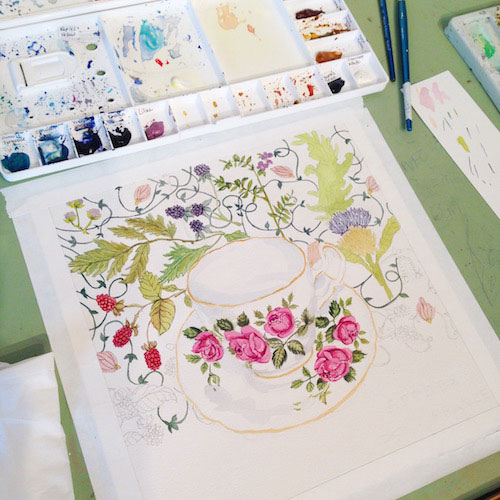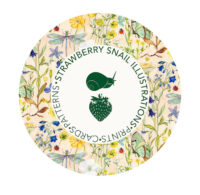 My first introduction to botanical painting was probably before my teens when I found The Country Diary of an Edwardian Lady by Edith Holden on my mom’s bookshelf. I devoured that book for hours and every now and again I still pull it off my shelf. So I can say I’ve had a life-long obsession with vintage botanical illustration.
My first introduction to botanical painting was probably before my teens when I found The Country Diary of an Edwardian Lady by Edith Holden on my mom’s bookshelf. I devoured that book for hours and every now and again I still pull it off my shelf. So I can say I’ve had a life-long obsession with vintage botanical illustration.
In 2007 I think it was, I found artist Gennine Zlatkis creating her own hand-painted fabric using Spoonflower and I wanted to do it so badly but it seemed so far beyond my ability. Nowadays it seems like every other illustrator is making their own fabric thanks to a growth in technology making it affordable, to companies like Spoonflower, but also to larger companies who are licensing designs from independent artists. No more excuses!
Now that I’ve just uploaded my design to Spoonflower (finally!) I wanted to share my process. Please note this is not a “how-to”. My process is always based on instinct—creating and solving problems as I know how.
First I created a 10×10 in. drawing on sketch paper. I looked at a number of vintage prints of berries, thistles and flowers as reference, and without putting too much thought into arrangement and relying only on instinct, I just kept drawing until I had filled the page. I drew a vine entwining all the elements as a way of adding more depth and interest. I was looking at William Morris pattern a lot and loved the way he complicated his patterns with so many layers of leaves and I really liked that density.
At the same time I had started what I wanted to be a series of still life paintings (teacups) with pattern behind it instead of a traditional table setting. This stemmed from a painting class I took at the Toronto School of Art with Moira Clark, who had us paint a still life, and take a piece of found fabric and paint the pattern as a background. This was back in 1999! So I decided to use my botanical drawing as a background for the teacup and in so doing, procrastinate making a fabric pattern (again).
First I drew my teacup on a piece of 10×10 in. Arches watercolour paper. Then, using my lightbox, I traced my botanical drawing onto the watercolour paper, only tracing what was around the teacup. Since most of the visual interest in the botanical drawing was in the centre and would be covered by the teacup, I shifted the centre of the drawing above the teacup, and shifted the top of the painting below the teacup.
Once I started painting the teacup, it became clear to me that although my pencil drawing was correct, somewhere along the line in painting the pattern on the cup correctly (with perspective), along with painting the shadows, the perspective of the teacup was now incorrect. I made the decision to keep going rather than correct it, because I felt that my focus and exercise was more about painting pattern, rather than making a traditional still life (also an exercise in letting go!)
I used the watercolour really concentrated, with just enough water to really load the brush, “scraping” the pigment over and over since I wanted really saturated colour. I separated the colours into shapes, layering shades from light to dark. I also used a lot of titanium white on the top layers to create highlights and depth and varying tone. I used a no. 1 brush to make sure I was able to include all the lovely details of line and colour in real life.

Fast forward 4 months of illustrating a children’s book, and I finally finished the piece.
Now that the procrastination project was done, there was still the issue of making a fabric pattern. Because I’m a masochist, I thought it might be fun to paint the same subject all over again and see how different I paint it using the same parameters, and 4 months later. I carved out an hour of painting every morning, so that I had no excuses! I documented the process on Instagram and Facebook.
I was surprised at how little of an area I had accomplished in an hour, which was definitely an eye opener for me. I’m always trying to explain to people that it takes A LOT of time to complete a painting, but I hadn’t realized to the extent! I did get a comment on Facebook that said it shouldn’t have taken me that long, which I thought was a bit weird (for so many reasons), but the bottom line is, it takes as long as it takes and it’s different for everyone. I happen to be really anal about details—that’s what I ENJOY about making work. 
My next step was to take this to Photoshop and create a repeat pattern. Phew! I had NO idea how to do this, so it took some research on a few people’s blogs and some trial and error to do this. I’m not going to go into it here, because that’s for another post entirely, but let’s just say it took some cutting and pasting to get rid of the seams to make a continuous repeat. Here’s a screen shot:

My next step once I get the fabric in the mail (cross fingers I’ve done it right), is to haul out the old sewing machine from the garage and start applying it to several products; cushion covers, cloth napkins, maybe even a duvet cover!
Another application for this design was Thank You cards, which are also in the process of being shipped to me. (nowadays I’m getting my designs printed instead of cutting and printing at home which just got too time consuming and expensive) I blew up the pattern in Photoshop, only including a small section of it. These will be in the shop soon:

That’s all for now, friends. Enjoy your Sunday. Make and share!
